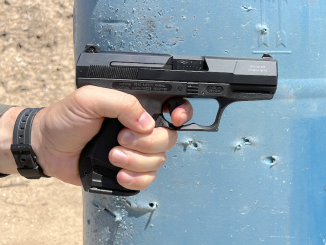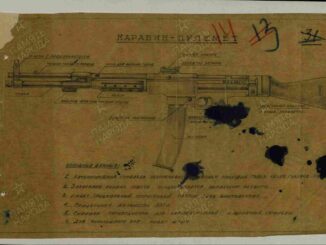Today we are looking at one of the rarest and earliest rifles built by Paul and Wilhelm Mauser, a design which would set in motion all the events that led to the Mauser company becoming one of the great world leaders in small arms. The Mauser brothers were born in Oberndorf am Necker in the Kingdom of Württemberg, sons of a gunsmith. They would take up their father’s trade and were creative and intelligent boys, but opportunities were limited in the small, rural town of Oberndorf. In 1865 they presented a rifle to the Austrian Army in Vienna for trials, where it was rejected. However, it was noticed by an American sales rep for the Remington Company, a man named Samuel Norris. Norris saw the potential in the Mauser brothers’ design to convert needlefire rifles to metallic cartridges, and he signed a deal with the brothers to further develop the system.
The Mauser’s moved to Liege Belgium to do their work, and within just a few years they were making rifles for Norris. This example is based on a Chassepot, as Norris hoped to sell the conversion system to the French Army. That deal was rejected, however (the French were happy sticking with paper cartridges as of 1868), and Norris’ plans began to unravel when the Remington company discovered that he was making dealings in his own name instead of for them. The Mauser brothers ended up walking away from the deal with ownership of the patents they had filed with Norris, and when they submitted the design to the Prussians a process began which would result in the Mauser Model 1871 being adopted. From there, their talents would lead to the whole line of Mauser repeating rifles culminating in the Model 1898, arguably the pinnacle of the bolt action military rifle.
Thanks to the Liege Arms Museum for access to film this for you! If you are in Belgium, definitely plan to stop into the museum, part of the Grand Curtius. They have a very good selection of interesting and unusual arms on display. Further thanks to the Paul Mauser Archive for helping to arrange this filming!




Absolutely gorgeous! I love the lines of the stock and the simple elegance of that striker spring (even though it’s probably not as long-lasting as a modern coil). Few rifles made today have bluing as beautiful as that 150-year-old finish!
“(…)Oberndorf am Necker(…)”
Wait. So far I know it was Oberndorf am Neckar. Does I have not actual data or this is simply British name for location known in Deutsch as Oberndorf am Neckar?
“am Neckar” is all I’ve ever seen. More likely, it fell victim to spellcheck, which does not like non-English words.
cheers
eon
The Mauser brothers grew up in the gun factory. At a very young age they were allowed to build their own guns, but had to pay for the materials they used (probably by working in the factory)
I can applaud the Mauser brothers for treating the gun factory as an extension of a traditional skilled trade. I’m increasingly shocked that so many people nowadays are raised to believe that they’ll easily go to college, get a great degree, and that when they get out they’ll be getting high-position white-collar desk jobs that require very little effort (even in pushing pens) to receive BIG FAT PAYCHECKS. By 2050, I’ll be surprised if there’s even one carpenter, plumber, mason, machinist, or blacksmith left in America. I’m not kidding. Skilled trades are increasingly being treated as medieval superstitious stupidity or moronic tedious jobs best filled by ROBOTS, at least here in Cleveland.
Forgive my ranting, I’ve had a rough day. Back to the rifle: How much craftsmanship and manual tooling would be needed to make anything like it today without automated assistance? I’m including wood-working, forging the vital parts, and fine-tuning the whole assembly once it’s put together…
You picked not the best example, as this rifle looks fairly simple machining wise. But from the same period and later, there are lot of examples so complicated they would be prohibitely expensive even with modern tooling.
I often wonder why today more guns arent made with these old methods, as I think it adds value – its a difference in part that is machined from stock and same one that was investment cast, just like its not the same to have real leather or fur clothes and fake,mass produced plastic ones.
ln case of sufficient demand obtained, most of old firearms like C96, Luger, Thompson can be easily built with current manufacturing methods like, investment casting, MlM, CNC machining, etc… Most of them cost even cheaper but all of them would carry some traces of building methods like die parting lines… Outside of them look like the original but inside would not. C96’s hammer pin for instance; it is a single part pin with integral “V” spring at left and all machined out from a single piece forged spring quality steel. Today’s metod of making it, would be MlM and if it taken out, the die parting line would be seen even on the pin rod and push pin traces at the spring side together. Simply, we can remember the past but can not live. lMHO.
Left should be right…
“…can be easily built with current manufacturing methods like, investment casting, MlM, CNC machining, etc…”(C)
Can not.
Any design is created for the technology by which it will be manufactured.
The designers of the “old school” understood this. But current ones just take existing designs and try to reduce their cost using modern technologies…
However, they do not take into account that aerospace technologies require an appropriate production culture.
And when the work is done by a curve-hand, half-fool (in addition also indifferent to the result) who cannot be fired because he is a black-skin pretending to be gay, then it is natural that the output will be outright rubbish.
For most manufacturers, reputation has become an empty phrase, the main thing is profit.
And the fact that almost every tenth (or third) product is buggy and needs to be improved, is the user’s problem…
At age 75, having some firearm utily patents granted in the USA, lots of firearm design and building, l have been still trying to learn someting different from your posts. Thanks…
Maybe young people believe that because it’s the lie that our entire society spoon feeds us from the moment we start school. For what it’s worth, my generation (Millennials) now see and understand this lie for what it is. We are a generation that went to college, studied real degrees (no basket weaving), but then those great jobs didn’t exist when we got out (or not enough of them). So now we’re a generation of college educated cashiers and burger flippers, trying to pay down a mountain of student loans.
Sorry, that was for Cherndog. I thought my reply would “nest” below his, and I can’t edit, either
Don’t worry about it, and thanks for sharing your thoughts!
Chassepot is 1866 and not 1868
This was indeed cool!
The first german metalic cartrige rifle was the Werder, not the Mauser 1871!
The Werder rifle was bavarian, whereas the 1871 Mauser rifle was general issue across unified Germany. Which only had unified just that year in 1871. Before that a loose assembly of sovereign states made up the area known as Germany.
You’ve written nice post, I am gonna bookmark this page, thanks for info. I actually appreciate your own position and I will be sure to come back here. Thanks. shell shockers
Rich information, that’s really good, I’m looking for it, thanks for sharing.